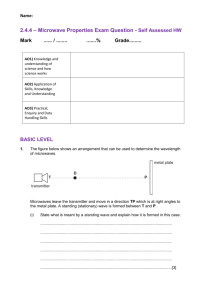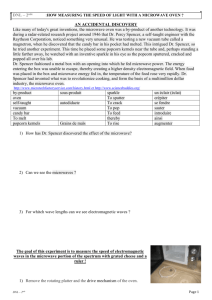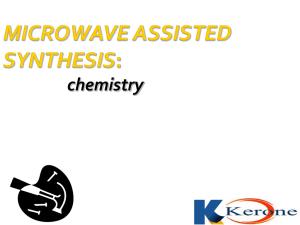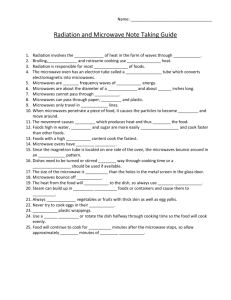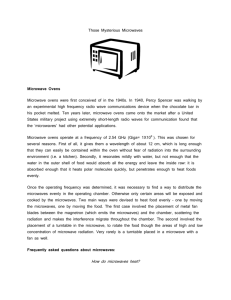1 - Jones International University
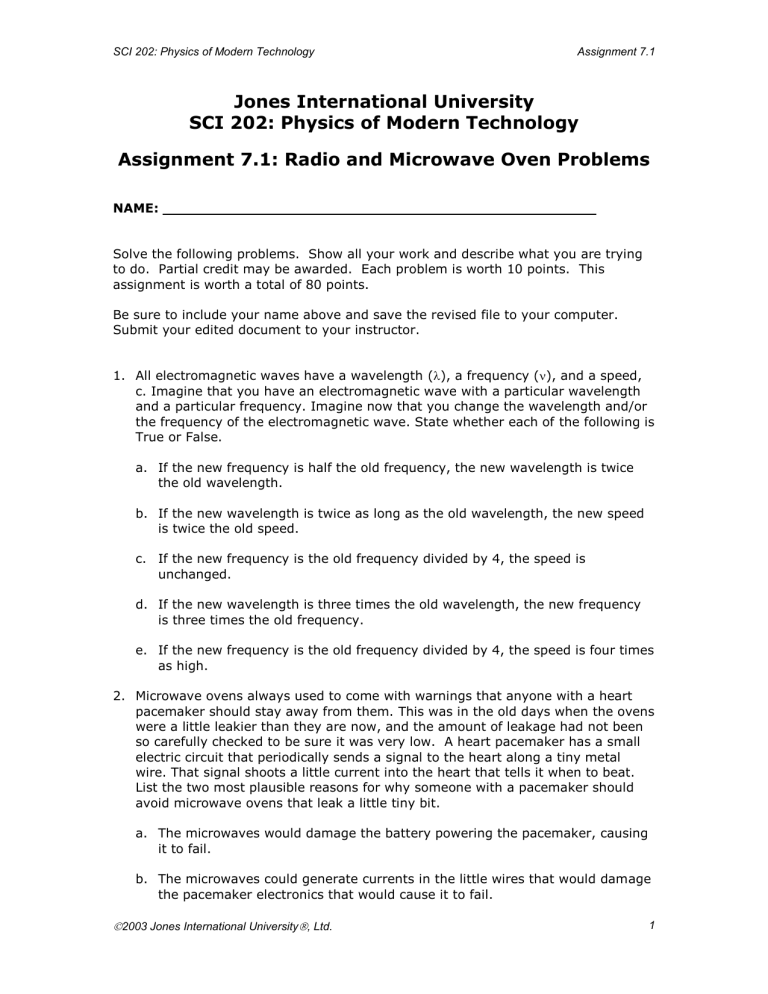
SCI 202: Physics of Modern Technology Assignment 7.1
Jones International University
SCI 202: Physics of Modern Technology
Assignment 7.1: Radio and Microwave Oven Problems
NAME:
Solve the following problems. Show all your work and describe what you are trying to do. Partial credit may be awarded. Each problem is worth 10 points. This assignment is worth a total of 80 points.
Be sure to include your name above and save the revised file to your computer.
Submit your edited document to your instructor.
1.
All electromagnetic waves have a wavelength ( ), a frequency ( ), and a speed, c. Imagine that you have an electromagnetic wave with a particular wavelength and a particular frequency. Imagine now that you change the wavelength and/or the frequency of the electromagnetic wave. State whether each of the following is
True or False. a.
If the new frequency is half the old frequency, the new wavelength is twice the old wavelength. b.
If the new wavelength is twice as long as the old wavelength, the new speed is twice the old speed. c.
If the new frequency is the old frequency divided by 4, the speed is unchanged. d.
If the new wavelength is three times the old wavelength, the new frequency is three times the old frequency. e.
If the new frequency is the old frequency divided by 4, the speed is four times as high.
2.
Microwave ovens always used to come with warnings that anyone with a heart pacemaker should stay away from them. This was in the old days when the ovens were a little leakier than they are now, and the amount of leakage had not been so carefully checked to be sure it was very low. A heart pacemaker has a small electric circuit that periodically sends a signal to the heart along a tiny metal wire. That signal shoots a little current into the heart that tells it when to beat.
List the two most plausible reasons for why someone with a pacemaker should avoid microwave ovens that leak a little tiny bit. a.
The microwaves would damage the battery powering the pacemaker, causing it to fail. b.
The microwaves could generate currents in the little wires that would damage the pacemaker electronics that would cause it to fail.
2003 Jones International University
, Ltd. 1
SCI 202: Physics of Modern Technology Assignment 7.1
c.
The microwaves could generate currents in the wires going to the heart and send it false signals about when to beat. d.
The microwaves could be absorbed by the metal fillings in the teeth, and the hot fillings would release the mercury they contain, thereby poisoning the person. People with bad hearts are less able to deal with small doses of poison like this. e.
The microwaves could damage the genes making it more likely the person would get cancer. People with bad hearts are more susceptible to cancer. f.
The microwaves could burn the skin and the heart would respond by having to beat faster, which would put more strain on it.
3.
Most materials, such as hard plastic or glass plates, even when carefully dried, have a very thin layer of water molecules that are rigidly stuck to them by a strong chemical bond. However, if you put a clean dry plate in a microwave oven, the surface of the plate does not seem hot and you do not see any steam coming off. As these observations suggest, in fact, the water on the surface does not heat up. Determine whether the following are True or False as possible reasons for the water on the surface to not heat up. a.
The microwaves are all rapidly absorbed by the plate. b.
If the layer of water molecules is thin enough, the microwave fields will go right on through without having any effect on the molecules. c.
The molecules are held so tightly at the surface they do not rotate back and forth very much. d.
The microwaves are reflected away by the plate so they never get to the water molecules. e.
There are so few molecules they seldom bump into each other as they rotate back and forth in the microwave field.
4.
If you decided to change the frequency of the microwaves used in the oven to
4.6 GHz, which of the following would be True or False?
Food would no longer heat up in the oven. a.
b.
The molecules will rotate back and forth more slowly. c.
The leakage through the door screen will increase slightly. d.
The spacing between the peaks and valleys in the standing wave pattern will get closer together. e.
The microwaves would travel faster in the oven.
5.
You are designing microwave ovens and you see that the rules are that the holes in the screen on the microwave door must have a diameter equal to one tenth of
2003 Jones International University
, Ltd. 2
SCI 202: Physics of Modern Technology Assignment 7.1
the microwave wavelength to prevent leakage from exceeding the legal limit. If you changed the frequency to be 5.5 GHz, what is the largest diameter that you could make the holes in the door screen?
6.
Assume the chemical structure of the three molecules CH4, NH3, and HCl are as pictured, with the hydrogen atoms (white balls) all tending to be positively charged. Rate the three molecules as Good, Fair, or Poor, (where water is Good) with regard to how well a liquid of each of these molecules would heat up in a microwave oven. Remember that in a liquid, there are many molecules oriented in many different directions relative to the electric field. a.
CH4, methane b.
NH3, ammonia c.
HCl, hydrogen chloride
7.
The frequency of the radio waves used for cell phones is 833 MHz. What is the optimum antenna length for broadcasting or receiving cell phone signals?
8.
After installing a wall of metal filing cabinets along the back wall of your office, you find that reception for your favorite FM station at 105 MHz has become terrible. Your radio can barely get a signal at all. At first you think that the cabinets must be blocking the signal from the station but then you realize that cannot be the case, because the broadcast antenna for the station is directly in front of your office while the radio is in the middle and the cabinets are along the back wall. Fortunately, you have taken physics and so you realize that by moving your radio a small distance in the office you can get even better reception than you had before. How much farther away from the file cabinets should you move the radio than it is sitting now?
2003 Jones International University
, Ltd. 3

